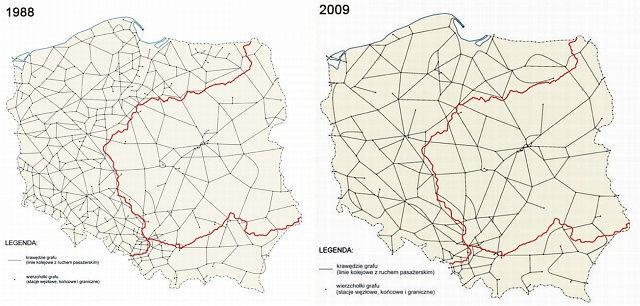Downgrade of Polish Railway System Map


Alex Cartwright
Senior Cartographer & GIS Specialist
Alex Cartwright is a renowned cartographer and geographic information systems specialist with over 15 years of experience in spatial analysis and data...
Geographic Analysis
What This Map Shows
The "Downgrade of Polish Railway System Map" provides a stark visual representation of the decline in railway infrastructure across Poland. It highlights the significant reductions in operational railway lines and services that have occurred over recent decades, reflecting a broader trend in the country's transportation network. This visualization allows viewers to understand not just the current state of the railway system but also the historical context behind its evolution and decline.
Poland's railway system was once one of the most extensive in Europe, connecting major cities and facilitating trade and travel. However, the map indicates a troubling regression, with many lines either decommissioned or severely underutilized. This decline mirrors similar patterns observed in other countries, such as Ireland, where railway networks have experienced significant reductions, raising questions about the future of rail transport in Europe.
Deep Dive into the Polish Railway System
The history of Poland's railway system can be traced back to the mid-19th century, when the first railways were introduced to facilitate trade and mobility. By the early 20th century, the network had expanded significantly, particularly in regions that were once part of the German Empire, the Austro-Hungarian Empire, and the Russian Empire. Each of these areas contributed different characteristics and standards to the railway system.
Interestingly, the map reveals a notable contrast between the pre-1918 German areas to the west and the Austro-Hungarian regions to the south and the Russian territories to the east. For instance, the western regions, which were more industrialized, maintained a higher density of railway lines, reflecting the economic activity in those areas. In contrast, the eastern parts, often less developed, saw a considerable decline in rail services over the years as investment waned and other forms of transport became more dominant.
In recent decades, several factors have contributed to the decline of the railway system in Poland. The rise of automobile ownership, coupled with the expansion of road networks, has made personal transport more attractive for many. Additionally, economic transitions post-1989 led to significant changes in funding and prioritization of public transport infrastructure. As a result, many rail lines were closed, and services reduced, leaving large swathes of the country with limited rail access.
Recent statistics illustrate this decline poignantly. For example, between 2000 and 2020, Poland witnessed a drop in its railway infrastructure by over 20%. Many small towns that once thrived on rail connectivity now face isolation, as they are cut off from both economic opportunities and social mobility. The average train speed has also decreased due to aging tracks and a lack of investment in modernization, leading to longer travel times and a less competitive position against other modes of transport.
Regional Analysis
When examining the map closely, it's clear that the impact of the railway downgrade is not uniform across Poland. The western regions, such as Lower Silesia and Lubusz Voivodeship, still retain a semblance of their former railway glory, with several lines operational and connecting major urban centers. These areas are more integrated into the European transport network, benefiting from cross-border connections and investment.
On the other hand, the eastern regions, like Podlaskie and Lubusz, are starkly different. Here, the map shows a significant lack of railway lines, with many towns completely abandoned by the railway system. The decline in these areas has profound implications for local economies, leading to reduced job opportunities and increased emigration to larger cities. The disparities are alarming, and the challenge remains for policymakers to find ways to reinvigorate these regions while balancing the needs of more urbanized areas.
Significance and Impact
Understanding the decline of the railway system in Poland is crucial for several reasons. First, it highlights the broader challenges facing public transportation infrastructure across Europe. As urbanization continues and environmental concerns grow, the need for efficient, sustainable transport solutions becomes increasingly urgent. Railways have the potential to reduce carbon emissions and alleviate road congestion, making their decline particularly concerning.
Moreover, the decline in railway services impacts not just transportation but also social equity. Regions that have been left behind face challenges in accessing education, healthcare, and employment. This has created a divide that policymakers need to address. There is a pressing need for investment in rail infrastructure that prioritizes not just the major urban centers but also the underserved areas. The future of Poland’s railway system could play a vital role in shaping economic development and social cohesion across the country.
Interestingly, discussions about reviving the railway system are gaining momentum, with various proposals for modernization and expansion. As Poland continues to evolve, the potential for a renaissance in its railway network could offer a path toward improved connectivity and economic growth, but it will require concerted effort and investment from both government and private sectors. The future of Poland’s railway network remains uncertain, but the discussions it provokes are essential for shaping a sustainable transport future.
Visualization Details
- Published
- August 17, 2025
- Views
- 98
Comments
Loading comments...